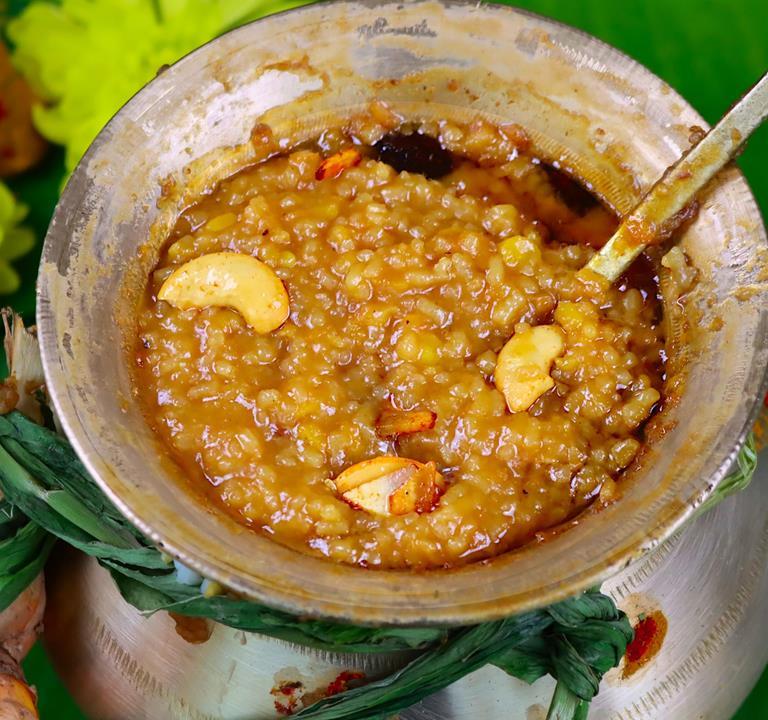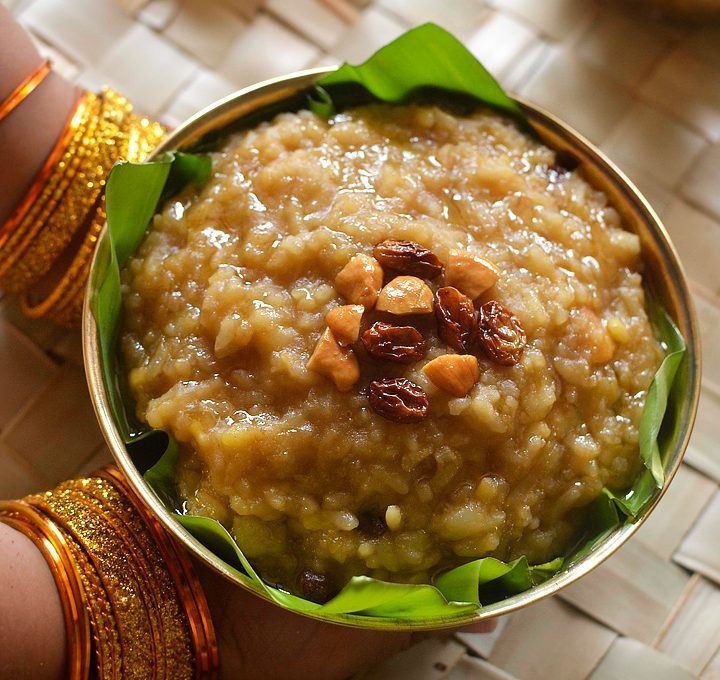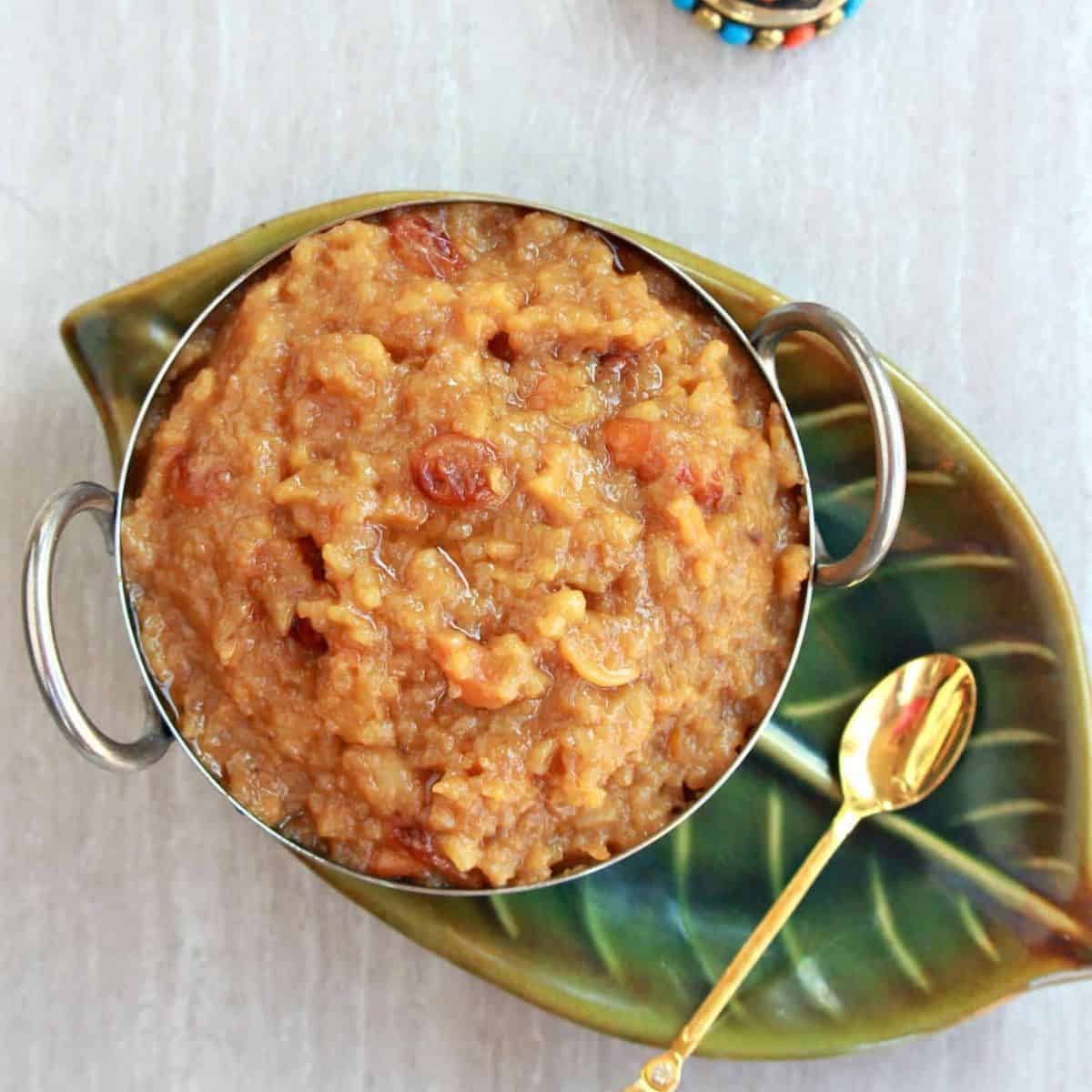Sakkarai Pongal, often spelt as “Sakkarai” or “Sakkara” and colloquially known as Sweet Pongal, is a divine concoction that marries the simplicity of rice with the sweetness of jaggery, interspersed with the luxuriousness of ghee and the crunch of an assortment of nuts. This traditional South Indian dessert finds its significance not just as a culinary treat but also as a cultural symbol, especially during the harvest festival of Makar Sankranti or Pongal, after which it’s named.
The dish starts with short-grained rice, commonly the nurturing staple of the land, combined with moong dal (split yellow mung beans) to introduce a subtle richness in texture. Together, they are simmered to a velvety consistency, then sweetened with jaggery—a concentrated product of date, cane juice, or palm sap—and finished with a generous drizzle of ghee for an aromatic satiny sheen. This saccharine delight is further embellished with cardamom, edible camphor (for those who favor its piquant note), and a delightful sprinkle of roasted cashews and raisins, offering moments of nutty reprieve amidst the lushness of this sweet porridge.
Sakkarai Pongal Swee Jaggery Rice Recipe


Sakkarai Pongal Swee Jaggery Rice
Equipment
- 1 medium skillet
Ingredients
- 1/4 cup split yellow mung beans
- 1/2 cup short-grain rice such as sona masoori, rinsed in cool water, drained
- 2 cups plus 2 tablespoons water divided
- 2 tablespoons ghee
- 10 raisins
- 10 cashews
- 3/4 cup grated jaggery
- 1 whole clove crushed using a heavy-bottomed pot or other heavy object
- 1 green cardamom pod crushed using a heavy-bottomed pot or other heavy object
- 1 cup milk
- 1/8 teaspoon edible camphor optional
Instructions
- Heat a medium skillet or kadai over medium heat.
- Add the split yellow mung beans and dry-roast for 5 to 7 minutes until they turn golden brown.
- In a saucepan over medium heat, combine the rice, roasted mung beans, and 2 cups of water. Cook for 20 minutes, stirring every 3 minutes. Using a potato masher, mash the cooked rice and lentils in the pot.
- In a large skillet or wok over medium heat, melt the ghee.
- Add the raisins and cashews and cook for 30 to 45 seconds, until the raisins become plump. Transfer the raisins and cashews to a small dish and set aside.
- Return the skillet to medium heat and add the remaining 2 tablespoons of water. When the water begins to simmer, add the jaggery and let it melt.
- Stir in the clove, cardamom, milk, and the mashed rice and lentils.
- Add the edible camphor (if using). Reduce the heat to low and cook for 10 to 12 minutes, stirring every 2 minutes. Turn off the heat.
- Stir in the raisins and cashews.
Notes
is residue, strain it through a fine-mesh strainer set over a bowl, return the water to the pot, and continue with the recipe.
Cooking Tips about Sakkarai Pongal SweeJaggery Rice

- Quality of Ingredients: Select high-quality jaggery, preferably organic, as it serves as the main sweetener. Good jaggery should be free of impurities and have a rich, deep color that will contribute to the flavor and color of the Pongal.
- Rice and Moong Dal Ratio: Use short-grain rice like Sona Masoori in combination with moong dal. A typical ratio is 1 part rice to 1/4 part moong dal. This ensures a creamy texture where the rice grains are soft and the dal provides a subtle richness.
- Roasting the Moong Dal: Lightly roast the moong dal before cooking until it exudes a nutty aroma. This enhances the flavor profile of the Pongal.
- Jaggery Syrup: Dissolve the jaggery in a little water and strain it to remove any debris before adding it to the cooked rice and dal mixture. This results in a smooth texture.
- Cardamom Powder: Add freshly ground cardamom towards the end of cooking for a fresh fragrance. The spice adds a delightful aroma and complements the sweetness of the jaggery.
- Edible Camphor (optional): A pinch of edible camphor can be added for its unique aroma, but use it sparingly as it’s quite strong.
- Cashews and Raisins: Fry cashews and raisins in ghee till golden brown and add these to the Pongal. They offer not just crunch and texture but also additional layers of taste.
- Consistency: The Pongal should be relatively thick yet moist. Add milk or water as needed to adjust the consistency before serving, as it continues to thicken upon cooling.
- Use of Ghee: Be generous with clarified butter (ghee). It enriches the Pongal and is key in achieving the classic decadent flavor.
Serving suggestions about Sakkarai Pongal Swee Jaggery Rice

- Temperature: Serve Sakkarai Pongal warm to enhance its flavors and aromas. If serving it as part of a festival meal, ensure it retains its warmth by keeping it covered until serving time.
- Garnishes: Adding additional garnishes like roasted cashews, almonds, or even a sprinkling of grated coconut can introduce a variety of textures and accentuate the richness of the Pongal.
- Savory Pair: To balance the sweetness, pair it with a savory dish. South Indian savory foods like medu vada (savory fried donuts) or masala vadai can create an appealing contrast in flavors.
- Spiced Buttermilk or Lassi: A chilled glass of spiced buttermilk or savory lassi can cut through the heaviness and cleanse the palate between bites of the sweet Pongal.
- Fresh Fruits: Accompanying Sakkarai Pongal with slices of banana or diced mango can add a fresh element and make the dessert more refreshing.
- Paan or Betel Leaf: In some traditions, consuming paan after the meal aids digestion and refreshes the mouth, making it a suitable follow-up to the sweet course.
- Coffee or Tea: Pairing Sakkarai Pongal with a strong cup of South Indian filter coffee or tea can balance the sweetness with their bitterness and provide a complete taste experience.
- Side of Moong Dal Payasam: Offering a side of moong dal payasam (another type of sweet pudding) can give guests variety and allows them to appreciate the different types of sweetness and textures.
Top 5 FAQs about Sakkarai Pongal Swee Jaggery Rice

- What type of rice is best suited for making Sakkarai Pongal? Short-grained rice is traditionally used for Sakkarai Pongal because it absorbs the jaggery syrup well and results in the right consistency for the dish. Commonly, varieties such as Sona Masoori are preferred for their creamy texture when cooked.
- How do you ensure the jaggery mixes well without any lumps? To obtain a smooth consistency, jaggery should be melted with a little water and then strained to remove any impurities or debris. The resulting syrup is then mixed into the cooked rice and dal to sweeten the Pongal evenly.
- Is it necessary to use ghee, and how much should be used in Sakkarai Pongal? Ghee is a crucial element in Sakkarai Pongal, providing a rich aroma and flavor to the dish. While the quantity can be adjusted to taste or dietary preferences, being generous with the ghee is traditional and enhances the overall richness of the Pongal.
- Can Sakkarai Pongal be made vegan? Yes, Sakkarai Pongal can be made vegan by substituting ghee with a vegan alternative like coconut oil or vegan butter, which can mimic the richness to some extent, although the authentic flavor provided by ghee will not be completely replicated.
- What are the typical garnishes or add-ins for Sakkarai Pongal? Roasted cashews and raisins are classic garnishes that add texture and a nutty sweetness. Cardamom powder is also essential, adding its distinctive fragrant spice to the Pongal. Some people also add a touch of edible camphor, which imparts a unique aroma, but it should be used sparingly due to its strong flavor.
Sakkarai Pongal, also known as Sweet Pongal, is a traditional South Indian dish mainly prepared during the festival of Pongal, which celebrates the harvest season. This dish holds cultural significance, particularly in the state of Tamil Nadu, and marks the end of the winter solstice when the sun starts moving northward, signifying an auspicious period. It is considered a festive dish that symbolizes abundance and prosperity.

Leave a Reply